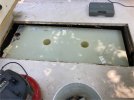Hookup1
GreatGrady Captain
- Joined
- Oct 16, 2007
- Messages
- 3,577
- Reaction score
- 1,011
- Points
- 113
- Age
- 71
- Location
- Cape May, NJ
- Model
- Islander
Drill the hole with a stepped bit. Take the shavings off as you go. You would have to take the sending unit out so blow it out, get a vacuum in there on a piece of copper tubing or PVC pipe.
Stepped bits are the best way to drill holes in plastic. Drill bits and hole saws make a mess and sometimes crack the plastic. I drilled holes for my chum buckets and 5-gallon bucket garden planters. Works great.
Use a piece of butchers twine or electricians pulling tape, pick it up with a vacuum thru sending unit hole. Thread fitting on and pull into place. Put a stop on both sides of the fitting and leave it long in case you have to pull it back out.
Stepped bits are the best way to drill holes in plastic. Drill bits and hole saws make a mess and sometimes crack the plastic. I drilled holes for my chum buckets and 5-gallon bucket garden planters. Works great.
Use a piece of butchers twine or electricians pulling tape, pick it up with a vacuum thru sending unit hole. Thread fitting on and pull into place. Put a stop on both sides of the fitting and leave it long in case you have to pull it back out.
Last edited:



